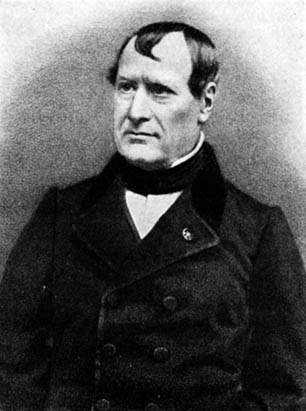<Back to Index>
- Physiologist Marie Jean Pierre Flourens, 1794
- Composer Alexander Vasilyevich Alexandrov, 1883
- Prime Minister of the Netherlands Pieter Sjoerds Gerbrandy, 1885
PAGE SPONSOR

Marie Jean Pierre Flourens (13 April 1794 – 6 December 1867), father of Gustave Flourens, was a French physiologist, the founder of experimental brain science and a pioneer in anesthesia.
He was born at Maureilhan, near Béziers, in the département of Hérault. At fifteen he began studying medicine at Montpellier, where in 1823 he received the degree of doctor. In the following year he went to Paris, carrying an introduction from A.P. de Candolle, the botanist, to Georges Cuvier, who received him kindly, and took an interest in him. At Paris Flourens engaged in physiological research, occasionally contributing to publications; and in 1821, at the Athénée, he gave a course of lectures on the physiological theory of the sensations, which attracted much attention amongst men of science.
In 1825, Flourens pioneered the experimental method of carrying out localized lesions of the brain in living rabbits and pigeons and carefully observing their effects on motricity, sensibility and behavior. His intention was to investigate localisationism, i.e., whether different parts of the brain had different functions, as the Austrian physician Franz Joseph Gall, the founder of phrenology, was proposing. The trouble was that Gall did not use a proper scientific approach to this affirmations, and the Academy of Sciences of Paris, acting on order of the emperor Napoleon Bonaparte, asked Flourens to solve the matter.
Flourens was able to demonstrate convincingly for the first time that the main divisions of the brain were indeed responsible for largely different functions. By removing the cerebral hemispheres, for instance, all perceptions, motricity, and judgment were abolished. The removal of the cerebellum affected the animal's equilibrium and motor coordination, while the destruction of the brainstem (medulla oblongata) caused death. These experiments led Flourens to the conclusion that the cerebral hemispheres are responsible for higher cognitive functions, that the cerebellum regulates and integrates movements, and that the medulla controls vital functions, such as circulation, respiration and general bodily stability. On the other hand, he was unable (probably because his experimental subjects have relatively primitive cortices) to find specific regions for memory and cognition, which led him to believe that they are represented in a diffuse form around the brain. So, different functions could indeed be ascribed to particular regions of the brain, but that a finer localization was lacking.
The paper which published his results, entitled Recherches experimentales sur les propriétés et les fonctions du système nerveux dons les animaux vertébrés (Experimental Researches on the Properties and the Functions of the Nervous System in Vertebrate Animals), was the subject of a highly commendatory report by Cuvier, adopted by the French Academy of Sciences in 1822.
Flourens was chosen by Cuvier in 1828 to deliver a course of lectures on natural history at the Collège de France, and in the same year became, in succession to LAG Bosc, a member of the Institute, in the division "Economic rurale." In 1830 he became Cuvier's substitute as lecturer on human anatomy at the Jardin du Roi, and in 1832 was elected to the post of titular professor, which he vacated for the professorship of comparative anatomy created for him at the museum of the Jardin the same year. In 1833 Flourens, in accordance with the dying request of Cuvier, was appointed a perpetual secretary of the Academy of Sciences; and in 1838 he was returned as a deputy for the arrondissement of Béziers. In 1840 he was elected, in preference to Victor Hugo, to succeed Jean François Michaud at the French Academy; and in 1845 he was created a commander of the légion d'honneur, and in the next year a peer of France. In 1841, he was elected a foreign member of the Royal Swedish Academy of Sciences.
In March 1847 Flourens drew the attention of the Academy of Sciences to the anesthetic effect of chloroform on animals.
On the revolution of 1848 he withdrew completely from political life; and in 1855 he accepted the professorship of natural history at the Collège de France. He died at Montgeron, near Paris on 6 December 1867.